
|
The first movementsThe first movements, according to the level of affection, will be different for every person, but the general outline will be very much alike for all types of haemorrhage of the brain. We learn to sitStaying at hospital for a long time you got used to lying in bed. Try to train yourself to vertical way of life. When you are more or less OK ask somebody to help you to sit on bed. At first don't try to sit as long as possible. Feeling giddy, lie again. Extend hte time of sitting gradually. When sitting, control position of your legs, don't bend them when they touch floor, distribute weight on both legs evenly. We learn to standTrying to stand, remember, that muscles of your leg are weak and most of them are atrophied. Keep in mind that muscles of non affected leg are weak too and some of them, to crown it all, may be atrophied too. Somebody must help you during the time you learn to stand. When trying to stand, use non-affected leg first then the other one. You'll have peculiar feeling when, after several week in bed, you touch the floor with your own legs. In due course, muscles will begin doing their work, accordingly inflow of blood to lower extremities increases, neuron chains begin to restore themselves. Be ready for feeling bad or giddy, for itch in your leg. We learn to walk
If your physical condition allows you to stand, you may begin making your first steps. Very likely it will be very difficult for you to make first steps and to keep upright. You'll need an assistant. He or she holds you from the affected side, putting your arm on his neck and fixing your affected bend of knee with his knee. This method is not bad, not taking into consideration some peculiarities. It is difficult to hold your assistant with the affected arm, because its perciptive and pain sensibility is still very low and you can't feel the power you lean against your assistant, besides the affected arm with its low sensitivity gives you unpleasant feelings. We'll have complications with leg as well. In most cases, making a step, you place your leg aside and the assistant's leg he tries to fix your knee with, will hinder. We go on walkingEvery person needs different time for learning to walk. But, taking everything into consideration in one or three months try to walk without any help. Of course your first movements will be clumsy, it will be difficult to walk on stairs, but in any case you'll do it. Let your assistant have a rest. Don't be vorry for yourself. Now it's the time to improve the achievements you have. After a time a flat floor or pavement won't give a sufficient load for your leg. A very simple medium for giving load for your leg is thick, high grass or deep snow. You'll have a very interesting effect walking in water with level up to your knee or lover. The most suitable place to have such trainings is swimming pool. The problem, they never fill swimming pool up to that level. Exercise 1
One of the problem you'll meet is impossibility of bending your knee. Different groups of muscles are responsible for bending and unbending your leg. In most cases only the group of muscles unbending the leg in bend of knee will work. So, our main task is to train to bend our knew. You lie on your back and unbend the leg. Ask your assistant to bend it. Then unbend it again. Repeat this exercise lot of times. As a result your leg works passively - you don't operate it, your assistant bend it. Exercise 2 |

a |
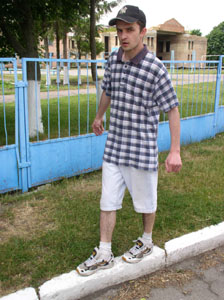
b |
|
Picture a. One of the ways of training of your bend of knee. Place your affected foot on a border stone and walk along the road. To understand the way of doing of this exercise, first place your unaffected leg on border stone and try to walk.
Exercise 3Doing this exercise improve the muscles drawing your leg aside and at the same time it trains your bend of knee. While doing this exrecise try to keep a long distance between the left and the right feet. The most simple way of doing it - walking on edges of concrete slabs. We may differentiate the load on the legs, using slabs of different width you may walk not only along slabs as shown in the picture. Draw two parallel lines with necessary distance between them on a float surface. You may use a long narrow carpet if it does not slip on the floor. Don't forget to walk both forward and back. 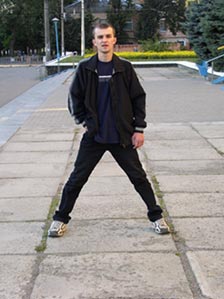
Exercise 4 |
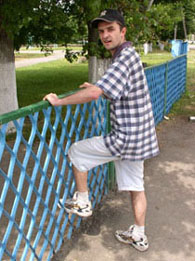
a |
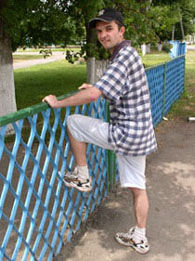
b |
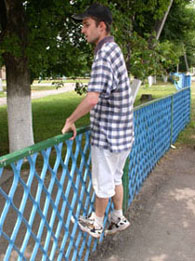
c |
|
A difficult exercise. Good for improving your leg. There is a fence of this kind in every town. If you have no fence of your own, use your neighbour's one. The task is to lift your body using the affected leg. We may place the foot higher or lower thus changing the load on the leg (Picture a, b) Having placed the feet, lift yourself (Picture c). Doing this exercise, use your arms training the affected one. Exercise 5 |

|
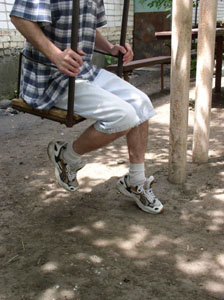
|
|
Use simple swing. |

|